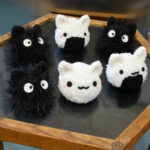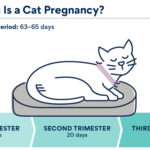The Selkirk Rex stands out in the feline world with its distinctive curly coat, a feature that sets it apart and endows it with an endearing, almost tousled appearance. This breed is not just about looks; it’s a study in balance and substance, combining a robust build with a sweet and engaging personality. As a medium to large cat, the Selkirk Rex boasts a heavy bone structure that belies a surprising weight, giving an overall impression of power and solidity. While females may exhibit a slightly less massive physique than their male counterparts, they are by no means delicate. Active and affectionate, the Selkirk Rex is a breed that embodies harmonious proportions and a gentle nature, making it a captivating companion.
Breed Standard: Delving into the Selkirk Rex Characteristics
The Selkirk Rex breed standard meticulously outlines the ideal physical attributes of this unique cat, ensuring that breeders and judges alike can appreciate and maintain the breed’s distinctive qualities. Let’s explore each aspect in detail:
Head: The Foundation of the Selkirk Rex Look
The head of the Selkirk Rex is a defining feature, contributing significantly to its overall charm.
Skull: Rounded and Broad
The skull is described as round, broad, and full-cheeked in both males and females. This roundness should be palpable, feeling smooth and curved from the stop to the back of the head. The breadth extends across the forehead and between the ears, emphasizing a substantial and well-formed skull structure.
Muzzle and Chin: Balanced Proportions
The muzzle of the Selkirk Rex is of medium width, with a rounded underlying bone structure. Well-padded whisker pads contribute to a slightly square appearance. In profile, the muzzle is clearly visible beyond the curve of the cheek, and its length is approximately half the width. A subtle nose stop is present in the profile, adding to the breed’s distinct look. The chin is firm and well-developed, balanced in proportion to the rest of the head, neither receding nor protruding excessively. The bite can be either level (where top and bottom front teeth meet evenly) or scissors (where the inside edge of the top front teeth touches the outside edge of the lower front teeth), both considered acceptable within the breed standard.
Ears and Eyes: Expressive Features
The ears are medium in size, broad at the base, and tapering to a point. They are set well apart and should integrate seamlessly into the rounded contour of the head without disrupting its shape. If present, ear furnishings are curly, echoing the breed’s signature coat. The eyes are large, rounded, and set widely apart, contributing to the Selkirk Rex’s sweet and open expression. They should not appear almond or oval-shaped. The outer corner of the eye is set just slightly higher than the inner corner, enhancing the breed’s gentle and engaging gaze.
A detailed view of a Selkirk Rex head, showcasing the breed-standard round skull and curly features.
Body: Substance and Balance
The body of the Selkirk Rex is characterized by its substance and balanced proportions, reflecting its sturdy and powerful nature.
Torso: Rectangular and Muscular
The torso is medium to large, well-balanced, and substantially muscular. It is more rectangular than square, possessing a solid build without being overly elongated. The back is straight, with a slight rise towards the hindquarters. The shoulders and hips should appear to be of equal width, contributing to the overall balanced appearance of the cat.
Legs and Feet: Proportionate and Strong
The legs are medium to long, with substantial boning that is proportionate to the body. This strong bone structure adds to the cat’s impression of weight and power. The feet are large, round, and firm, providing a stable base. Selkirk Rex cats have five toes on their front feet and four on their hind feet, a typical feline trait.
Tail: Medium Length and Proportionate
The tail is of medium length, proportionate to the body, and heavy at the base. It should taper towards the tip, being neither blunt nor sharply pointed, maintaining a balanced and harmonious line with the rest of the body.
An overview of a Selkirk Rex body, demonstrating the breed’s balanced proportions and muscular build.
Coat: The Defining Curly Feature
The coat is arguably the most distinctive feature of the Selkirk Rex, resulting from a dominant, spontaneous mutation that affects each hair, from guard to down and awn. This mutation imparts a gentle curl to the coat, giving it a soft and plush feel that is truly unique.
Coat Length: Short and Long Variations
Selkirk Rex cats come in two coat lengths: shorthair and longhair. The most noticeable differences in coat length are on the tail and ruff.
- Shorthair: In shorthairs, the tail hair is approximately 1-2 inches long, similar to the coat length on the body. The tail curls are plush and lie compactly around the tail. The ruff, the fur around the neck, is also the same length as the body coat.
- Longhair: Longhair Selkirk Rex cats exhibit tail curls that are plumy and stand out away from the tail. The ruff hairs are longer and frame the face, creating a more dramatic and luxurious appearance.
Shorthair Coat Texture, Curl, and Density
- Texture: The shorthair coat texture is soft, plushy, and full, with an obvious curl.
- Density: The coat is dense and full, covering the body completely without any bald or thinly covered areas. It stands out from the body, giving a voluminous appearance and should not appear flat or close-lying.
- Curl: The curl is random and unstructured, arranged in loose, individual curls that often appear in “clumps” rather than as an overall wave. While the degree of curl can vary based on hair length, sex, and age, the entire coat should display the effect of the rex gene. Curliness is often more pronounced around the neck, on the tail, and on the belly. It is important to note that younger adults and kittens may exhibit less curl.
Longhair Coat Texture, Curl, and Density
- Texture: The longhair coat texture is also soft, full, and obviously curly. While it may not feel as plush as the shorthair coat, it should still be substantial and not appear thin.
- Density: Similar to the shorthair, the longhair coat is dense and full, with no bald or thinly covered areas. It may stand out from the body but might feel and appear less plush than the shorthair, while still avoiding a close-lying or flat appearance.
- Curl: The curl in longhairs is also random and unstructured, presenting as loose, individual curls, often in “clumps” or “ringlets.” Like shorthairs, the curl can vary with hair length, sex, and age, but the entire coat should show the influence of the rex gene. Curliness tends to be more evident around the neck, tail, and belly. Allowance should be made for less pronounced curls in younger cats.
A longhair Selkirk Rex displaying its distinctive curly, plumy coat and ruff.
A shorthair Selkirk Rex coat close-up, showing the characteristic dense, plush, and curly texture.
Color: A Spectrum of Possibilities
The Selkirk Rex breed standard is remarkably inclusive when it comes to color, accepting any genetically possible color or combination of colors. This wide range ensures diversity and allows for a stunning array of coat appearances. Eye color is also unrestricted, further adding to the variety within the breed.
Accepted Colors and Patterns
From solid colors like pure white, dense black, and various shades of blue, red, cream, chocolate, lavender, cinnamon, and fawn, to complex patterns such as shaded, chinchilla, smoke, tabby (classic, mackerel, spotted, patched), tortoiseshell, calico, bi-color, and colorpoint variations – the Selkirk Rex can exhibit an incredible spectrum of coat expressions.
Detailed Color Descriptions
The breed standard provides detailed descriptions for each color and pattern, ensuring clarity and consistency in judging. For instance, a “White” Selkirk Rex should be a pure, glistening white with pink nose leather and paw pads. A “Black” should be a dense coal black from roots to tip, with black nose leather and paw pads. Tabby patterns are described in detail, differentiating between classic, mackerel, and spotted variations, each with specific marking requirements. Colorpoint variations, similar to Siamese patterns, are also recognized, including seal point, chocolate point, blue point, and lilac point, among others. Mink and Sepia patterns, offering a richer, deeper color saturation, are also part of the accepted palette.
Color Class Numbers
For show purposes, Selkirk Rex cats are categorized into Longhair and Shorthair divisions, with “All Championship Colors” classes available in each division. “AOV” (Any Other Variety) classes are also provided for cats that may not perfectly fit within the standard color descriptions but are still exemplary Selkirk Rex specimens.
Penalties and Disqualifications
While the Selkirk Rex standard is comprehensive, it also outlines penalties and disqualifications to ensure the breed’s integrity.
Penalties
“Excessive cobbiness or sleek oriental appearance” are considered faults. The Selkirk Rex should maintain its balanced, substantial build, avoiding extremes in body type.
Disqualifications
Disqualifications include more severe deviations from the standard, such as “extreme nose break,” “lack of visible muzzle,” “malocclusion” (misaligned teeth), “tail kinks,” “crossed eyes,” and “obvious physical deformities,” including polydactyl feet. Crucially, “no evidence of curl” is also a disqualifying trait, as the curly coat is the defining characteristic of the Selkirk Rex.
Outcross Breeds and Breed Purity
Historically, outcrossing was permitted to Persian, British Shorthair, or Exotic breeds to broaden the gene pool and maintain health. However, the standard evolves, and currently, Selkirk Rex kittens born on or after January 1, 2025, must have only Selkirk Rex parents, emphasizing the move towards breed purity and the establishment of the Selkirk Rex as a fully self-sustaining breed.
Conclusion: The Allure of the Selkirk Rex
The Selkirk Rex is more than just a curly coat; it’s a breed defined by balance, substance, and a gentle charm. Its unique coat, combined with a sturdy build and sweet temperament, makes it a captivating breed for enthusiasts and families alike. Understanding the breed standard allows for a deeper appreciation of the Selkirk Rex and ensures the preservation of its distinctive traits for generations to come. Whether you are a breeder, a judge, or simply a lover of cats, the Selkirk Rex offers a delightful blend of distinctive appearance and endearing personality.


